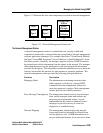
GigWorks MkII-16 Switch Model MKII-BASE16
Installer's/User's Manual 59003-01 Rev. A
Switch Management 3-49
Managing the Switch Using SNMP
Figure 3-13 illustrates the four main components involved in network management.
Figure 3-13. Network Management Framework
The Network Management Station
A network management station is a centralized node (usually a dedicated
workstation) connected to a network that runs some kind of network management
software application (manager). For example OpenView™ from Hewlet Packard,
NetView™ from IBM, Spectrum™ from Cabletron, or SunNet Manager™ from
Sun Microsystems. Generally, the manager supports and uses SNMP to monitor
the network and collect information from the agents in the network. The manager,
rather than the agents, has the intelligence to use and interpret the information
provided by the agents. This information enables the administrator to examine the
statistics and monitor the network for performance or operation problems. The
network management station provides the following principal functions:
Function Description
Managing Nodes The administrator can manage network nodes,
either remotely or locally, by issuing SNMP
commands from the management station and
receiving responses to queries. Most management
stations provide user-friendly interfaces.
Error Message Clearinghouse The management station receives error messages
from various managed nodes and initiates any
necessary pre-programmed actions. A good
implementation also retains a database of error
messages to provide a history of events for
diagnostics or troubleshooting.
Network Mapping The management station displays the network
layout map based on information collected from
various agents as well as MIB information in an
easy-to-understand manner. It can also show alarm
Node
SNMP
Agent
Management
Station
MIB
Software
SNMP
Manager
Node
SNMP
Agent


















